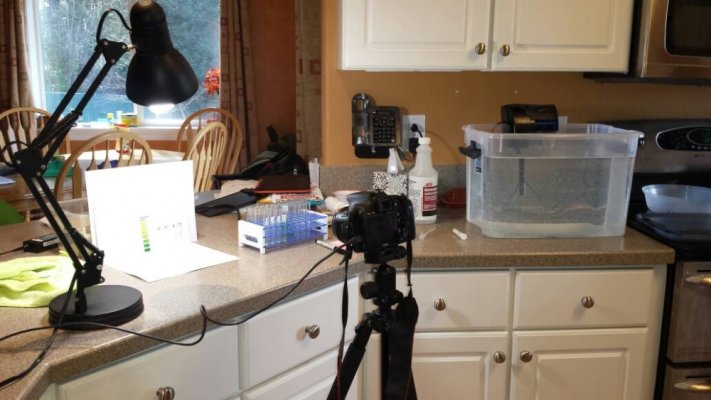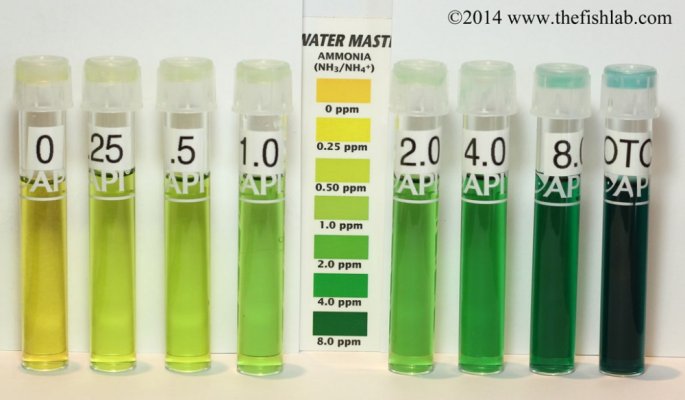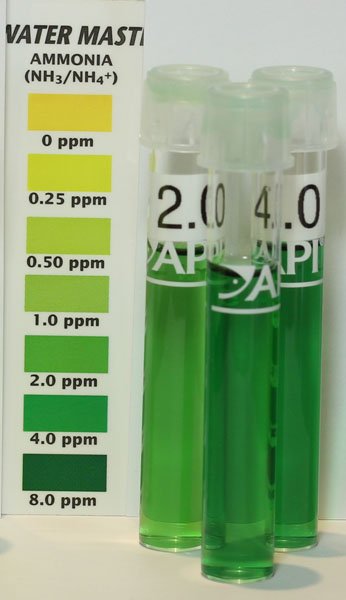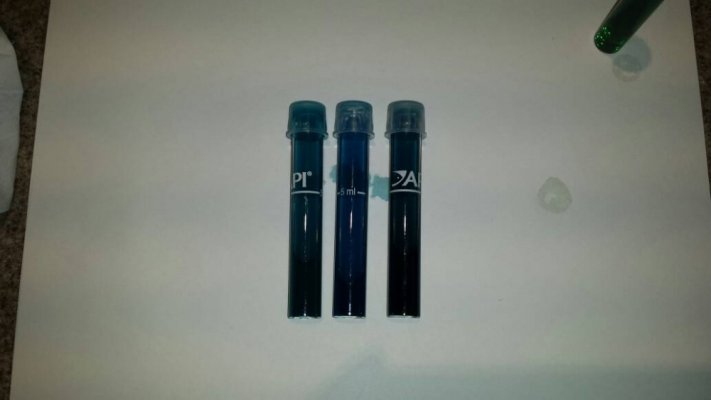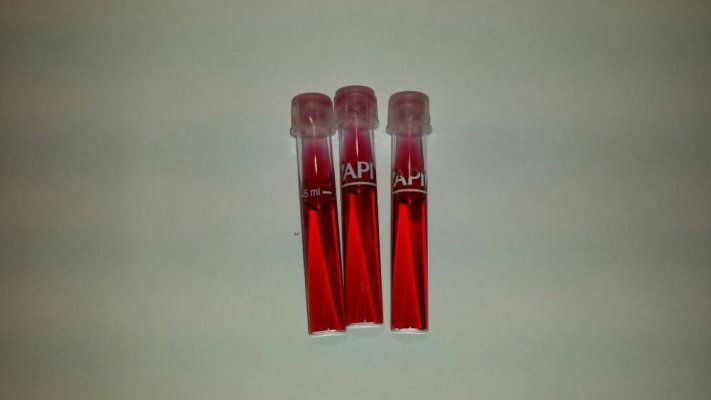You are using an out of date browser. It may not display this or other websites correctly.
You should upgrade or use an alternative browser.
You should upgrade or use an alternative browser.
Experiment: Extreme cycle
- Thread starter threnjen
- Start date
The friendliest place on the web for anyone with an interest in aquariums or fish keeping!
If you have answers, please help by responding to the unanswered posts.
If you have answers, please help by responding to the unanswered posts.
Rak9378
Aquarium Advice Activist
Wow you've even got the test tube holder going!!! Professional!! 
threnjen
Aquarium Advice Addict
Caliban07
Aquarium Advice Addict
threnjen
Aquarium Advice Addict
OK here's an additional post that's kind of a bummer.
That middle vial is a grab from the cycling tank (diluted as normal). When compared directly with a 2 or 4 vial, it's definitely not as I had thought. It doesn't appear to differ much from 4 after all.
I had thought it was distinctly lighter than my initial tests from the tank. But I'm noticing that in the absence of a "control" this is really impossible to estimate from day to day. I would say that this potentiallyy makes my early ammonia readings, where I thought it had dropped, invalid.
pH and kH drops are not invalid however.
Also, to increase reliability of future readings, I have made a "control solution" which is 4ppm. I will now run 2 ammonia tests each time I test the cycling tank, using both the tank water and the control. Then I should be able to compare these more accurately and properly identify if the tank is reducing ammonia.
I can also dilute my control solution as needed to control for any other lesser ppm.
So, not the best news. But it did seem too good to be true.
If the tank is not reducing ammonia though -why are the pH and kH dropping?
Perhaps I added slightly more than 16ppm to begin with, and it is now slightly under? I think there is a potential error range of 1-2ppm ammonia. I think there is not going to be definite information until the tank has CLEARLY reduced at least into the 1-2ppm range.
That middle vial is a grab from the cycling tank (diluted as normal). When compared directly with a 2 or 4 vial, it's definitely not as I had thought. It doesn't appear to differ much from 4 after all.
I had thought it was distinctly lighter than my initial tests from the tank. But I'm noticing that in the absence of a "control" this is really impossible to estimate from day to day. I would say that this potentiallyy makes my early ammonia readings, where I thought it had dropped, invalid.
pH and kH drops are not invalid however.
Also, to increase reliability of future readings, I have made a "control solution" which is 4ppm. I will now run 2 ammonia tests each time I test the cycling tank, using both the tank water and the control. Then I should be able to compare these more accurately and properly identify if the tank is reducing ammonia.
I can also dilute my control solution as needed to control for any other lesser ppm.
So, not the best news. But it did seem too good to be true.
If the tank is not reducing ammonia though -why are the pH and kH dropping?
Perhaps I added slightly more than 16ppm to begin with, and it is now slightly under? I think there is a potential error range of 1-2ppm ammonia. I think there is not going to be definite information until the tank has CLEARLY reduced at least into the 1-2ppm range.
Attachments
Just throwing this out there for fun  Will make a nice addition to your lab
Will make a nice addition to your lab 
IO Rodeo Inc. | Smart lab technology



IO Rodeo Inc. | Smart lab technology



threnjen
Aquarium Advice Addict
WOW!!!!
...... my lab wants a colorimeter so badly.....
Thanks for sharing, that is amazing.
...... my lab wants a colorimeter so badly.....
Thanks for sharing, that is amazing.
I wonder if the bacterial bloom has been adding some ammonia?
Kittykat364
Aquarium Advice Freak
- Joined
- Nov 22, 2013
- Messages
- 443
This seems to prove that amounts higher than the max on the chart don't give a false zero.
Rak9378
Aquarium Advice Activist
This seems to prove that amounts higher than the max on the chart don't give a false zero.
I'm still not 100% convinced. Thren's awesome experiment and the "OTC" reading was for ammonia and I was referring to Nitrite. The color references for Nitrite posted by Rare, which was an awesome find, only goes up to 2ppm. That said, it occurred to me that Dr. Hovanec doesn't disclose the Nitrite concentration he used in that experiment. So I think this is something I will dig into a bit further. Maybe an email to API to see what they have to say about it.
Sorry Thren...didn't mean to hijack your thread with my rambling thoughts!
threnjen
Aquarium Advice Addict
Which paper? The one on nitrospira has the amounts in the graphs of how high nitrites reached. I can't recall the most that was reached off the top of my head.I'm still not 100% convinced. Thren's awesome experiment and the "OTC" reading was for ammonia and I was referring to Nitrite. The color references for Nitrite posted by Rare, which was an awesome find, only goes up to 2ppm. That said, it occurred to me that Dr. Hovanec doesn't disclose the Nitrite concentration he used in that experiment. So I think this is something I will dig into a bit further. Maybe an email to API to see what they have to say about it.
If you mean another paper I am very, VERY interested in that as I've only read his nitrospira paper.
Someone in the "Getting Started" area coincidentally just had their nitrates so high that they got zeros in test. They did the test three times. Then they did a 50% water change and the test showed 80ish. So if this happens it might be dependent on which test we are talking about.
I can guarantee you that when cycling I have had ammonia levels higher than 16ppm... I have seen the vial so dark green that it was like a deep forest green-black, even darker than my OTC vial. So I'm not sure if there is a point where it zeros out for ammonia.
Also, I need to do some more looking into this weird pH color that I had. I'm starting to feel "suspicious" about it somehow.
Here were today's test results for the cycling tank. No changes today, at all.
TDS 94 (not statistically significant difference)
kH 6-7
pH 7.4-7.5
Nitrites 0
Ammonia ? I didn't test again after earlier test, where it appears to be at least 14ppm
PO3/4 7
Rak9378
Aquarium Advice Activist
Which paper? The one on nitrospira has the amounts in the graphs of how high nitrites reached. I can't recall the most that was reached off the top of my head.
If you mean another paper I am very, VERY interested in that as I've only read his nitrospira paper.
I was actually referring to the YouTube video I posted a link for earlier in the thread. He actually shows how the API Nitrite test gives a zero reading when Nitrites are actually much higher than what the tests are capable of registering. But now I'm questioning this as he doesn't disclose the nitrite level in his sample. He also says that this applies to the ammonia test kit. As you just tested yourself, the kit is able to register a very dark green for 16ppm, so how high does it have to go for the false zero? And at that level is it really relevant for the general hobbyist? I have sent an inquiry to API to see if I can get there perspective. I will report back if I hear anything.
threnjen
Aquarium Advice Addict
Rak9378
Aquarium Advice Activist
Note to self....in order to avoid false zero reading when conducting next fishless cycle don't dose more than 200 ppm of ammonia... 
I was actually referring to the YouTube video I posted a link for earlier in the thread. He actually shows how the API Nitrite test gives a zero reading when Nitrites are actually much higher than what the tests are capable of registering. But now I'm questioning this as he doesn't disclose the nitrite level in his sample. He also says that this applies to the ammonia test kit. As you just tested yourself, the kit is able to register a very dark green for 16ppm, so how high does it have to go for the false zero? And at that level is it really relevant for the general hobbyist? I have sent an inquiry to API to see if I can get there perspective. I will report back if I hear anything.
I have seen an article on this. Will see if I can find. From memory conditions mostly outside normal tanks were needed to get odd readings eg very high ph. Wish I had kept it now.
threnjen
Aquarium Advice Addict
Left to right. .. 320, 640, 1080 ppm nitrate
Interesting to note they are all exactly the same color.
They are however, as you can see, A, color
I'll make a nitrate spectrum chart next (when I have time)
(when I have time)
Sent from my SGH-M919 using Aquarium Advice mobile app
Interesting to note they are all exactly the same color.
They are however, as you can see, A, color
I'll make a nitrate spectrum chart next
Sent from my SGH-M919 using Aquarium Advice mobile app
Attachments
Rak9378
Aquarium Advice Activist
This is great stuff!! I wish there was an easy way to test nitrite like this!!
threnjen
Aquarium Advice Addict
I know  Nitrite is going to be near impossible to get exact (plus I can't forcibly dose it somewhere to try to achieve off the chart readings)
Nitrite is going to be near impossible to get exact (plus I can't forcibly dose it somewhere to try to achieve off the chart readings)
What could I use? Potassium Nitrite? I don't think you can buy that easily since it is an ingredient for explosives...
What could I use? Potassium Nitrite? I don't think you can buy that easily since it is an ingredient for explosives...
I knowNitrite is going to be near impossible to get exact (plus I can't forcibly dose it somewhere to try to achieve off the chart readings)
What could I use? Potassium Nitrite? I don't think you can buy that easily since it is an ingredient for explosives...
Search in Ebay

jwh0818
Aquarium Advice Addict
Search in Ebay
Haha! I don't think you can easily buy it there either!
Similar threads
- Replies
- 2
- Views
- 622
- Replies
- 8
- Views
- 719
- Replies
- 29
- Views
- 793
- Replies
- 3
- Views
- 482

